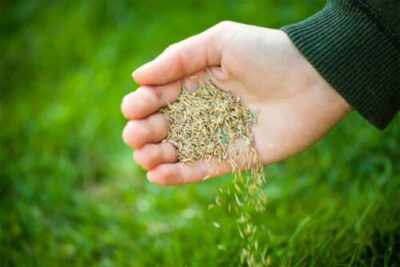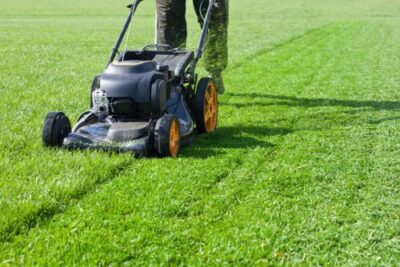Overseeding your lawn is an essential part of annual lawn maintenance, allowing you to infill any damaged or bare patches of grass on your lawn.
However, if you’re new to gardening you might be wondering: How long after overseeding can I mow?
Disclosure: This article may contain affiliate links – that means we may receive a commission if you make a purchase after clicking on these links. This is at no extra cost to you.
In this article, I will cover some key information about overseeding, including how long after overseeding you can mow and a step-by-step guide on how to overseed an existing lawn.
Keep reading to find out more.
How long after overseeding can I mow?
After overseeding your lawn, making sure you give your lawn a rest from mowing provides your lawn with the best chance of growing. Mowing causes a lot of unrest on your lawn, and you’ll need to wait to ensure the grass seeds have the best chance of thriving.
While some individuals might consider waiting 7 to 10 days after they have overseeded their lawn as a conservative estimate, it’s good to wait around a week or more if possible.
This allows the new grass seeds to settle, and this time after overseeding should be sufficient enough.
That being said, when the time comes for you to pull out your mower, it’s best that you have it on the longest height. After all, you don’t want to risk ruining all of your hard work!
A guide on how to overseed an existing lawn
Overseeding an existing lawn is relatively simple. For the best results when overseeding, you need the temperature to be mild and plenty of rain.
As a result, the most suitable months to overseed an existing lawn is either spring or autumn.
Prepare your lawn
- Begin by preparing your lawn. Weed the lawn either by hand or using weed killer to ensure that the lawn is
- Next, you will need to remove any stones and debris from the lawn to ensure it is clear.
- Scarify the soil to remove any moss from the grass and to loosen the soil.
- Fertilize the soil with a quick-release fertilizer. This will give your lawn the quick boost it needs in preparation for reseeding, basically it will help your lawn grow and fill out more quickly.
Overseed your lawn
- To begin, mow your grass to approximately 25mm in length.
- Moisten the soil with a hose or a watering can.
- Sprinkle the seed onto the grass evenly – apply more in patchy or thinner areas.
Water your lawn
Once you have laid your grass seed down, it needs plenty of water. This might be once or twice a day, depending on the weather.
- Water your lawn regularly after reseeding. You can irrigate the area twice a day if it’s a relatively hot day. What matters is that the soil gets enough moisture to support root establishment.
- Continue to mow the grass regularly with care and attention.

Tips when overseeding your lawn
When watering the grass, little and often is best. You should water your lawn every day after overseeding until your new grass is established, particularly if there has been only light rainfall or no rain at all.
However, be aware that you shouldn’t drown the seed by overwatering it.
Pay extra attention to the first cut after overseeding, as you need to provide your grass seed with the best chance of establishing itself in your lawn. As a result, you need to take a little extra care.
Try to keep traffic on a freshly overseeded lawn to a minimum for 7 to 21 days if you have the time. This means ensuring no one walks on the lawn, thus providing your lawn with the best chance of filling out as best as it can.
Choose your timing correctly! Timing your seed projects to coincide with growing cycles is important for the success of your lawn.
For the majority of places, fall is the best time to plant grass seed as the conditions are right and rainfall tends to be more frequent depending on where you live.
This is when cool-season grasses such as Kentucky bluegrass peak in growth, and conditions enhance fast germination and establishment.
Raise mowing heights to approximately 50mm for the initial 2 or 3 cuts, then reduce down to 25mm over the next 2 or 3 cuts.
In summary
Generally speaking, you should wait for a minimum of a week or more if you have the time before you mow your lawn after overseeding it.
Making sure that you choose your timing wisely is fundamental to the growth of your lawn. As a result, you should always overseed in either fall or spring to ensure the conditions are right.
Once you have overseeded your lawn, its success is reliant on you frequently watering the lawn and ensuring that it doesn’t receive too much traffic as the seeds become established.


